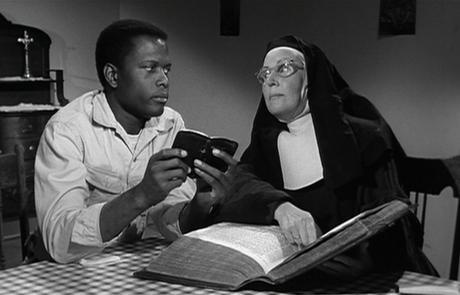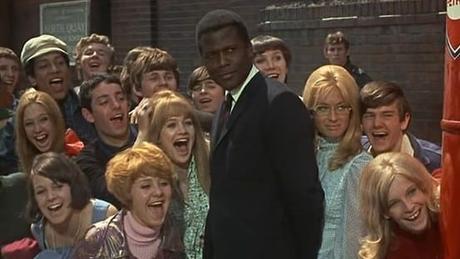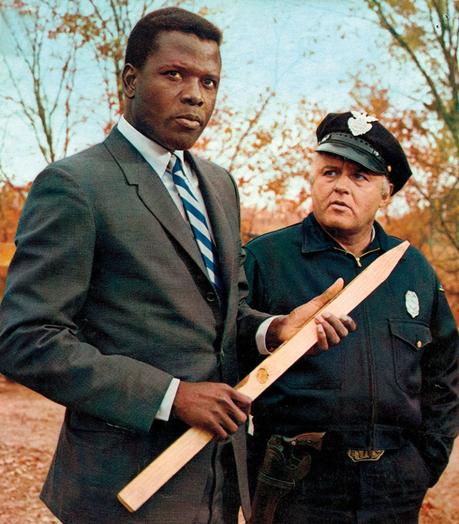 Sidney Poitier during 2006 Cannes Film Festival - Opening Night Gala - Inside at Palais de Festival in Cannes, France. (Photo by Toni Anne Barson/WireImage)
Sidney Poitier during 2006 Cannes Film Festival - Opening Night Gala - Inside at Palais de Festival in Cannes, France. (Photo by Toni Anne Barson/WireImage)
There will be many tributes to the late actor-director Sidney Poitier.
The Florida-born, Bahamian Islands native is sure to be honored in death, as he was in life, for having been the first Black male to win an Academy Award as Best Actor for the 1963 movie Lilies of the Field. Not necessarily a fair representation of his abilities overall, Poitier's outer calm and inner fire captured the attention of audiences from the very start of his stage and screen career.
That career came about amid the turbulence of the 1950s and sixties, if you can believe it. A time of increased racial tension and polarization.
Poitier's official birthdate, February 20, 1927 (some sources give the year as 1924), failed to indicate that he had come into this world several months too soon. The term "premature" is often used. Not expected to live, little Sidney overcame this apparent setback, mostly through his mother's prayers and an inherent ability to rise above the challenges. There would be more challenges to come. If anything, the rumors of Poitier's early passing had been greatly exaggerated.
I will not attempt to convey every facet of Poitier's life and work. That's best done by others. Still, most people familiar with the actor's output, especially those from the early fifties to the 1970s and eighties, would have known in advance about his contributions to the form. What I will do, then, if I can beg your indulgence, is relate my experience with his work to the times in which we lived.
I remember first seeing Poitier on our twelve-inch TV set, that tiny black, white and gray window to the world at large, where everyone and everything was reduced to miniscule proportions. Was this correct? No, not really. The proper setting for your favorite stars was in the movie theater. Larger than life, that's the ticket. Not something that I was privy to in my youth, however; certainly not on a regular basis. Too young, too soon, we were told. But you made do with what you had - and that's what we had.
How about that television? Nope. There simply weren't that many people of color represented on TV in the early to mid-1960s, period. Things changed, though. By the end of the decade the appearance of Black performers and artists of color became more prevalent. On both TV and in the movies. And you didn't need a color television set to tell you that.
'Lilies of the Field' (1963)
I finally got to see Poitier on the big screen when our high school held a special showing of Lilies of the Field. That's the one where a handyman (Poitier, naturally) was recruited, if you want to call it that - badgered is more to the point - by a group of enterprising German nuns (penguins in black-and-white habits) who cajole him into building a chapel out in the Arizona desert.
Say again? Build a what, out where? Those insistent nuns must have been out of their uninhibited minds, but what did I know about nuns, German or otherwise? Although baptized a Catholic, I was raised a Methodist. No matter, we got the idea that Sidney, with his solid work ethic and endless good cheer - in sum, his inbred concern for life's unfortunates - would give in and build those nuns their precious chapel.
From the direction the plot had taken, you'd expect the obvious would come about sooner rather than later. That is, the means justified the ends to which these nuns had gone to in order to get their way with our man Sidney, called Homer Smith in the film. Homer Smith? How boring, how bland. Oh, well, who said an actor's life was easy. As if what we had to face as kids weren't enough, adults too had to put up with what they could get. But Sidney got the better of the deal. He took home an Oscar for his efforts. Go get 'em, Sid!
Wait, what about that song? Some silly ditty or other that Homer taught those same nuns? I don't remember the words, but I do know the refrain: "Aaa-a-men! Aaa-a-men! Aaa-AAA-men, Aaa-men, Aaa-men!" Yeah, that's the spirit! A real "feel good" number. And so damn catchy, too. We came out of the auditorium chanting those same words: "Aaa-a-men! Aaa-a-men! Aaa-AAA-men, Aaa-men, Aaa-men!" A bunch of noisy Black, white, Irish, Hispanic, Chinese, Italian, and Jewish kids, joining in the refrain. Oh, that was fun! Never knew a film could do that to a person, let alone a bashful teenager in the first-year of high school.
Heck, that was back in '69, when I first saw Lilies of the Field. I learned a lot about perseverance from that flick, about charity and brotherhood, and having a solid work ethic, too. Was Sidney responsible? Not that I looked forward to working like a dog, the way Homer Smith did as he dove head-first into his labors. Man, they should have nicknamed him "Hercules," not Homer.
No matter, it was all Greek to me. And as far I could tell, those lilies were all lily white.
'To Sir, With Love' (1967)
So what would Sidney do for an encore? Well, now, we'd all heard about Poitier's next venture, To Sir, With Love from 1967. Even our teachers knew and talked about the movie. Curious, I wondered why. What was so special about this picture that attracted the attention of our teachers? A work filmed in Great Britain, of all places? And what did Merry Olde England have to do with the South Bronx where I resided? Quite a lot, I soon discovered.
With Poitier as our guide, the "Sir" in the title, how could I go wrong? In my naiveté, I imagined he had been knighted by Queen Elizabeth for services rendered - about as misguided an association as one could possibly have made. But again, I was wrong on that count too.
In that British-made production, Sidney played a teacher with an engineering background who, due to a lack of available opportunities, takes a job at a school in London's East End populated by miscreants and juvenile delinquents. Oh joy! You know the rest: The well-mannered teacher, or "Sir" as he insists upon being addressed, has trouble reaching out to those same rough-house, working-class young people.
Eventually, through discipline and so-called "tough love" (a term not even coined at the time) that includes a one-sided boxing match with one of the students, Sir manages to impose a semblance of order and discipline on his charges as well as earn their respect in the "claws-room." Do I hear a Pink Floyd number in progress? "We don't need no education, we don't need no thought control"? Not exactly, although one of the students, Babs (played by pop singer Lulu), warbles the title tune, "To Sir, With Love," at a dance gathering. The song went on to become a best seller in North America. Pink Floyd came later.
There's also a racial angle to the film, which was right up Sidney's alley. I didn't know this at the time, but the actor had, himself, played a delinquent in the earlier The Blackboard Jungle (1955). He was ably assisted by fellow troublemakers Vic Morrow and the unknown Jamie Farr. And it, too, featured a hit number, "Rock Around the Clock," sung by Bill Haley and His Comets, used intermittingly throughout. Funny how art can imitate life.
Another thing: These types of hard-hitting, ripped from the headlines features were common in not-so-merry England. In fact, this was a period marked by the phrase "Angry young men" that went on to become an accepted movie genre. Gritty dramas such as Look Back in Anger (1959), Saturday Night and Sunday Morning (1961), This Sporting Life (1963), and The Loneliness of the Long Distance Runner (1962) made stars out of angry young actors Richard Burton, Albert Finney, Richard Harris, and Tom Courtney, respectively.
Looking back myself - not in anger but in hindsight - at To Sir, With Love; and comparing this British-made product to what was happening in middle America (especially in the big cities), it's reasonable to assume that lack of opportunities for minorities and other ethnicities, in combination with prejudices and negative attitudes toward those same minorities, had contributed to growing racial tensions.
We were privy to this up close and personal. "In your face" was the everyday norm and, by any and all means, no exaggeration. Confrontations and trying to avoid them became commonplace. "What you lookin' at, man?" "Nothin', man, I ain't lookin' at nothin'." You better believe it... You looked the other way. And quickly.
'In the Heat of the Night' (1967)
One film that refused to look the other way, or turn the other cheek, was In the Heat of the Night. Your standard police procedural, an all-too-common feature of countless TV series from the fifties and sixties, passed through the kitchen blender in endless "repeat mode." But it finally met its match in Poitier's cultivated hands.
Here's one where an obviously intelligent Black police inspector, traveling incognito in plain clothes, is stopped and frisked and treated disrespectfully by bigoted Southern policemen from Sparta, Mississippi. Yep, you read that right: Sparta. The very name spells confrontation. Included was your stereotypical potbellied police chief, energetically portrayed by gum-chewing Method actor Rod Steiger. A man who took the heat of those nights seriously, so much so that he lived his part 24/7.
Chief Gillespie was the name, and blame was his game. That is, he and his police cohorts take it upon themselves to pin the murder of a rich industrialist on the least likely but most available suspect: a Black man in fancy clothing whose uppity manners and holier-than-thou "atty-tood" riles the chief to no end.
As for Sidney, moderation and restraint were in his blood, not exactly compatible with Steiger's more easily combustible persona. Nevertheless, I couldn't take my eyes off these two. What a pair! When they were in the scene, I felt as if I were in cinema heaven: This is what real stars looked like. They yelled at each other, shouted bloody murder. Steiger spewed forth racial epithets with as much bile and venom as any stereotypical Southern sheriff would do.
I questioned, to myself, why Sidney had to take such abuse from this ignorant hick. Even when it was revealed that Virgil Tibbs, Poitier's name in the film, wasn't a local but a visiting police detective from the big city of Philadelphia. That did it. That's all Chief Gillespie had to hear. And, boy, did Gillespie lay into Virgil with all the insult and injury in his possession. You could tell he was getting under Virgil's skin.
"You pretty sure of yourself, ain't you, Virgil? Virgil? That's a funny name for a nigger boy to come from Philadelphia! What do they call you up there?"
Yeah, Virgil, go on, tell 'em. What DO they call you in Philly? I wanted to know. Which is why my whole being stood on the edge of our living room couch, waiting for that punchline to hit: "They call me MISTER Tibbs!" Wham, bam! Down and out for the count.
Sidney's verbal comeback was nothing short of miraculous. But it paled next to the slap felt round the world. The one Inspector Tibbs gave another Southern bigot, the plantation owner Endicott (Larry Gates, a New York actor), and a chief suspect in the crime, an electrifying sequence that made movie history and audiences gasp in astonishment. WOW! Black man fights back! Never saw THAT before!
With battlelines drawn and the real culprit caught, an uneasy truce settles between Detective Tibbs and Chief Gillespie. They part ways, but with a grudging respect and acknowledgment of one another's abilities.
The remainder of Poitier's career led him to the director's chair, along with parts in more "staid" productions. He partook of the growing Blaxploitation film experience of the seventies and eighties. He helmed movies starring his lifelong friend and fellow civil rights activist Harry Belafonte. He appeared alongside comic Bill Cosby and directed Gene Wilder and Richard Pryor in farcical escapist forays. He starred as Supreme Court Justice Thurgood Marshall in a made-for-TV movie. And he appeared ever-so-sporadically in supporting parts, taking his acting career full circle.
But for me, personally, I still see him in my mind's eye as Detective Virgil Tibbs, as Sir, With Love, and as handyman Homer Smith. Always honest, always elegant, always self-aware. His eyes fixed, his chin out. His back firm and rigid, his stance straight and tall. The look of a self-possessed man. A Black man with dignity. And, above all, with pride. If his death be not proud, then let's focus on his life. Of that, we can all be proud.
So say it loud, people! Can we hear an "Amen" for Sidney Poitier? Go ahead, say it! I can't HEAR YOU!!!
That's better.
Copyright © 2022 by Josmar F. Lopes
